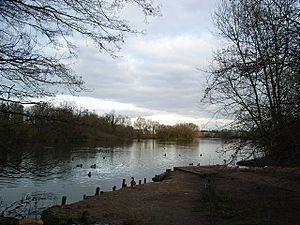Plantsbrook Local Nature Reserve facts for kids
Quick facts for kids Plantsbrook Local Nature Reserve |
|
|---|---|
 |
|
| Type | Local Nature Reserve |
| Location | Birmingham, England |
| Created | 20 March 1991 |
| Operated by | Birmingham City Council |
| Website | birmingham.gov.uk/plantsbrook |
Plantsbrook Local Nature Reserve is a special place in Sutton Coldfield, near Birmingham, England. It's a protected area where nature can thrive. This reserve has different types of natural spaces, including open water, wet areas (wetlands), forests (woodlands), and grassy fields (meadows).
It's located on Eachelhurst Road, right on the edge of the Pype Hayes and Walmley areas. Plantsbrook was officially made a Local Nature Reserve in 1991. This means it's recognized for its important wildlife and natural features.
Contents
What is Plantsbrook Local Nature Reserve?
A Local Nature Reserve (LNR) is a place set aside for nature and for people to enjoy. These areas are important for protecting wildlife and for teaching people about nature. Plantsbrook is one such place, managed by Birmingham City Council.
The reserve covers about 10.72 hectares, which is roughly the size of 26 football fields! It's used as a place where schools and groups can learn about the environment. It helps people understand how important it is to protect our natural world.
A Home for Wildlife
Plantsbrook Local Nature Reserve is home to many different plants and animals. Because it has various habitats, like water, wetlands, woodlands, and meadows, it attracts a wide range of species. Each part of the reserve offers something different for wildlife.
Wet and Wild: The Water Areas
The reserve gets its name from the Plants Brook that flows through it. This brook and other open water areas are vital for many creatures. You might spot different kinds of ducks, swans, or other water birds swimming here. Fish live in the water, and insects like dragonflies buzz around the surface.
The wetlands are marshy areas that are often flooded. These wet grounds are perfect for specific plants that love water, like reeds and rushes. Frogs, newts, and various insects also make their homes in these damp environments.
Green Spaces: Woodlands and Meadows
The woodland parts of Plantsbrook are filled with trees. These trees provide shelter and food for birds, squirrels, and other small mammals. In spring, you might see beautiful wildflowers growing on the woodland floor before the leaves on the trees fully open.
The meadows are open, grassy areas. They are often full of wildflowers in the warmer months, which attract bees, butterflies, and other pollinating insects. These insects are a food source for many birds. Meadows are also great places for small mammals like voles and mice to live.
Why is Plantsbrook Important?
Plantsbrook Local Nature Reserve plays a big role in its local community and for nature. It helps protect different types of habitats and the animals and plants that live there. Without places like this, many species could lose their homes.
It's also a fantastic place for education. Students and visitors can learn about ecosystems, biodiversity, and conservation. It shows how different parts of nature work together. Plus, it gives people a peaceful green space to relax and connect with nature.
Who Looks After Plantsbrook?
The reserve is managed by Birmingham City Council. They work to keep the habitats healthy and safe for wildlife. This includes looking after the trees, managing the water levels, and making sure the paths are clear for visitors. They also help organize educational activities at the reserve.

